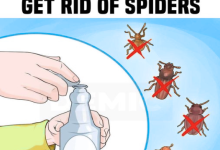You can make small shifts to improve the impact your cleaning routine has on the environment. We have 30 suggestions that are all so easy, you could start today.
Smart Swaps
1. Keep your disposable mop handle, but swap the disposable pads for reusable, washable microfiber ones.

These add-ons are designed to use the handle you know and love (and already have at home) but can be washed and repurposed over and over instead of tossing the pad at the end of each clean.
2. Trade your paper towels for sponge cloths, organic unbleached cotton cloths, or microfiber cloths.
As a reformed paper towel cleaner, I promise you’ll get used to it. Find a place in or near the kitchen to store clean clothes, and keep a “kitchen hamper” to toss dirty ones into every few days. Because I use microfiber, my hamper is a Guppyfriend bag I hang from a hook — I toss the bag into the wash and it also helps keep microplastics from shedding into the wash water.
3. When you’re ready to toss your sponge, consider a dish brush.
Cellulose dish sponges are great if you can compost them at the end of their life, but they do need to be replaced frequently, as often as once a week. A sturdy brush is still going to let you lather your dishes as you hand wash, but it can last a year or more with regular cleaning.
4. When you run out of dish detergent, try a dish soap bar.
Your cleaners don’t have to come in a plastic bottle. Dish soap bars do the same job but come packed and shipped in recyclable or compostable paper and cardboard instead. Keep one in a dish by the sink, lather up a brush and get to work.
5. When it’s time to re-up on cleaner, opt for a concentrate.

When it comes to nearly any cleaner you use at home — from laundry detergent to dish detergent to granite cleaner — there’s a brand out there trying to make the supply chain smarter and more eco-friendly. Cleaning products are mostly water anyway, which is heavy, and you’re paying to have that shipped to you even though it comes out of a tap at home. These concentrates come in smaller packaging that’s usually recyclable, and allow you to dilute it yourself at home.
6. Trade your fabric softener sheets for wool dryer balls.
Wool dryer balls absorb the heat from the dryer, helping to fluff and dry your clothes quickly, so you’re left with softer sheets and towels. If you want to add scent to your laundry, you can also drip some essential oils onto your dryer balls between loads.
7. Or, make your own cleaner! Baking soda, lemon juice, salt, vinegar
They’re pantry staples but also help create some excellent homemade cleaners. Use baking soda to de-grease in the kitchen, vinegar to clean scum in the bathroom, and lemon juice and salt to clean your cookware.
8. When you run out of disposable wipes, try a simple cloth and spray combo.

A cloth and spray cleaner is the same, but lets you reserve your cleaner (so you use only what you need) and repurpose your tools. Or you can DIY a container of wipes if you like the grab-and-go convenience — just roll a bunch of rags together in a jar and cover with cleaner.
9. When you’re on your last disposable duster pad, try sliding a sock on the end of the handle instead.
There’s not a whole lot of difference between a microfiber cloth and a microfiber sock. And socks just so happen to be shaped nicely to fit over the end of your disposable handheld duster.
Planet-Friendly Habits
There are ways to keep your existing habits and tools, but make them a little more planet-friendly with a little adjustment.
10. Wash your synthetic fabrics in a Guppyfriend bag.

Synthetic fabrics — like activewear, swimsuits, microfiber cloths, leggings, stretchy jeans, or really most things that have some stretch — shed microplastics into the water every time you wash them, which end up polluting oceans and waterways. Wash them inside a Guppyfriend bag to catch those plastics and prevent them from washing away.
11. If you need to throw away cleaner, do it safely.

Most liquid or semi-liquid water-based cleaners can be sent down the drain, according to the American Cleaning Institute, and solid cleaners like bar soaps can be composted or tossed in the trash. But a few cleaners — like oven cleaner or certain pesticides — are classified as hazardous waste and you may need to call your municipality to figure out how to safely dispose of them.
12. When you’re left with an empty bottle at the end of your cleaning routine, recycle it if you can.
Check the bottle for a recycling label and make sure it’s compatible with your municipality’s recycling process. In my city, I can only recycle “1” and “2” plastics, and tossing anything else into my bin may risk contaminating everything I’m trying to recycle. Also, just because it can be recycled doesn’t mean it will: Clean the bottle well, and remove and toss anything that’s not plastic — like the lid, or the sprayer top that has a metal spring inside — before putting the bottle in your recycling bin.
13. Pay attention to how much plastic is present with the cleaners you use.

Examine the packaging, plus what it shipped in if you’re buying cleaners online, and try to get away from plastic. You can swap plastic-bottled cleaners for cleaners that come as loose or pressed powder, or in recyclable glass or aluminum bottles. (Or look for cleaners that let you keep your sprayer and just buy new recyclable bottles.) And if your cleaner comes shipped in plastic wrap, look for a sustainably-minded source online that’s committed to paper shipping materials instead.
14. Don’t machine-dry your clothes.
If you can air-dry your clothes, do it! It uses less electricity, has a carbon footprint of zero, and helps your clothes last longer. You don’t need to buy a drying rack — you can hang clothes on the backs of chairs or over a fence or string outside. But if a new drying rack is what you need to commit to this habit, this one has great reviews.
15. If you have a cleaning task at hand that requires a special tool, see if you can rent or borrow one instead of buying a new one.
Some people get a lot of use out of tools like a steam mop or pressure cleaner, but not everyone. Give it a low-impact test run by renting or borrowing before you buy.
16. Read the labels on your cleaning products to make sure you’re not over-using them.
Conserving products is always a good idea. If you’re dosing higher than the label says you need to, you can definitely chill out on the cleaner. But even using the amount recommended on the label might be too much. Laundry experts say most people are using more laundry detergent than they need to, and detergent cap dosing cups aren’t helping.
17. Choose the right load size when you’re running the washer.

If you just select “large” every time, you could be wasting product and over-diluting your cleaner. Be mindful of those settings and choose the one appropriate to the load.
18. Wait to run the dishwasher until it’s full.
Unlike a washer, you can’t just tell a dishwasher to run a half-load. If you absolutely need to run the dishwasher and it’s not full yet, look for other things you can toss in there, like the microwave turntable, your countertop dish rack, or plastic or rubber kids’ toys.
19. Clean each room systematically.
It’s smart to work from top to bottom when you’re cleaning so that any dust or dirt that falls isn’t falling on top of an already-cleaned surface. Similarly, you can plot out your cleaning with a follow-the-wall strategy to make sure you don’t miss a spot or clean the same area twice.
Get Smarter With Single-Use
If you prefer to use disposable items for one reason or another, there are still some small ways to make your home habits greener.
20. If you use disposable mop pads, wipe them over a less dirty surface before using them on your floors.
They can pick up the tiny layer of dust from your console table and still get the floors sparkling clean.
21. Disposable pads can often be washed and reused.
They say single-use, but that’s not always true. If you have a light cleaning day, why not see if the tiny bit of dust washes off and lets you re-purpose that pad again for a deeper clean? Or move from one area of the house — like dusting the bedroom — then try to wash the pad off before going in on a germier surface like the bathroom floor?
22. If you like the convenience of disposable toilet brush pads, try something biodegradable.
Swap the tractable plastic toilet brush pads for something that’s made from natural materials and compostable, like coconut husks.
Reuse and Repurpose Your “Waste”
Just because you’re ready to retire something from use, doesn’t mean you can’t find a brand new use for it somewhere else at home.
23. Save the water you wash produce or grains with and use it to water your plants or even clean.
Rice water is actually great for cleaning since it’s slightly acidic and the starchy sediment in the rice water can act as a sort of abrasive.
24. When your sponge is retired from dish duty, cut off a corner and designate it for cleaning or wiping down your plants.

Even if you don’t want it touching your plates, it might still be good enough for the bathtub or your fiddle leaf fig.
25. When you’re done using your toothbrush, you can repurpose it as a detail cleaning brush.

Boil it to sanitize and so you can bend the handle and get into tight corners.







